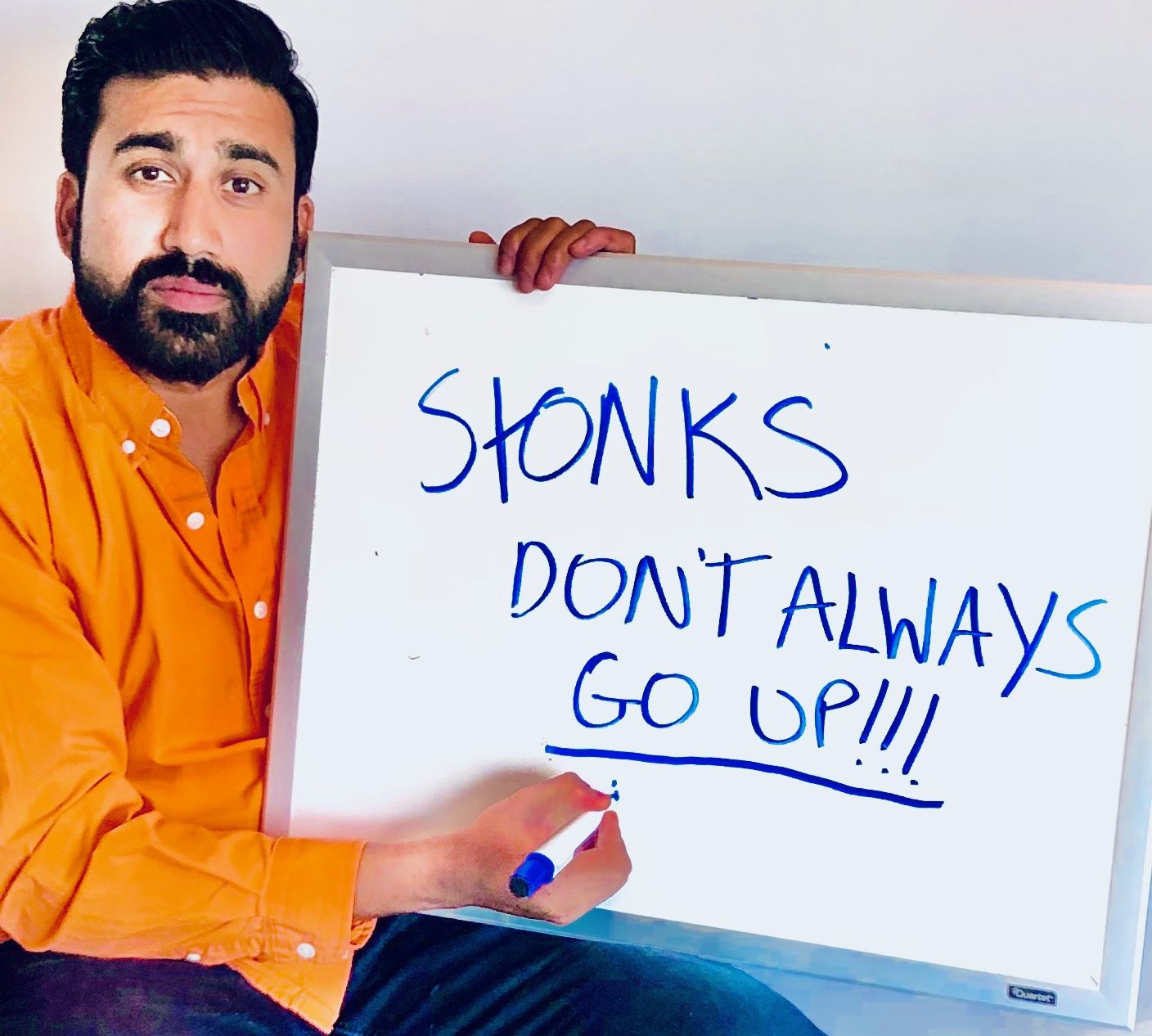Why are these major banks collapsing?
Enter: Fractional Reserve Banking and the House of Cares
You must have been living under a rock or at least a snowbank if you have not caught a whiff of what’s been going on south of the border and across the pond in the banking world.
Headlines are screaming about a possible banking system collapse as three large institutions (Silvergate Capital, Silicon Valley Bank and Signature Bank) have failed over the last three weeks. This is even affecting a major player in traditional finance, whose tentacles reach all corners of the world, Credit Suisse.
Over the following paragraphs, I will do my best (along with some help from Anthony Pompliano and Josh Smith from the Market Hustle) to explain what the heck is happening, why it is happening and what you can do about it.
In order to get an understanding as to why this is happening it’s important to consider our banking systems major tenant, fractional reserve banking.
To really sum it up, when people deposit cash into the bank, the bank has two options, it can either hold that cash on reserve (ie. Letting it sit there in case you come calling to withdraw it), or they can use it to earn interest (either by purchasing assets or lending it out). Here’s the key part, they do not lend it out one-to-one, but instead up to 10x. Meaning if you deposit $100, they don’t just lend out $100 but up to $1000! You might be asking, where the other $900 comes from, and voila, that’s exactly what credit is. Money that is lent into existence. Watch this video by Ray Dalio to get a primer on how the economy works.
This fractional reserve banking is how our current banking system operates and has been operating for decades. Sure, it has had a few collapses in the past but for the most part, runs smoothly. Until it doesn’t.
I found Josh Smith’s (@themarkethustle) breakdown of Fractional Reserve Banking and Piggy Bank Analogy quite helpful.
Imagine a small town with a big piggy bank...
Which is the town's bank. Everyone in the town puts their money in the piggy bank to keep it safe & secure... But the people who put their money in the piggy bank don't ALL need their money at the same time... Fractional reserve banking is like the piggy bank owner saying, "Hey, since not everyone is using their money right now, I can lend some of it out to other people who need it... ..and when they pay it back, they'll pay me a little extra for letting them use the $$$"
(that "extra" being interest)
The piggy bank owner doesn't lend out ALL of the money, just a fraction of it. The rest is kept in the piggy bank for people who need some of their money. This is the "fractional reserve" part. It means the bank is only keeping a fraction (or a piece) of the total money it has. And lending the rest out to other people to make some interest (or profit).
When the bank lends money to someone...
that person can spend it...
and then the person who GETS that money might put it in their own piggy bank...
That bank can then lend out a part of that money AGAIN.
This cycle can keep going & creates more money in the town (like magic)
Sounds pretty cool - huh?
But sometimes... things can get a little messy...
Here are 4 problems that can pop up:
Bank runs: Picture a wild rumor spreading in the town... making everyone panic and want to take their money back at the same time. Since the bank has only kept a PART of the money... it won't have enough to give everyone their cash at the same time. This is called a bank run.
Too much lending: If the piggy bank owner gets too excited and lends out too much money... it could lead to people borrowing more than they can pay back. This could make it hard for the bank to get its money back... and that's not cool for anyone involved.
Inflation: Remember how the magic piggy bank created more money for people to borrow? Well, sometimes there can be too much of a good thing... if there's a whole bunch of money floating around, the value of each dollar can drop. That is called inflation.
Financial instability: If the banks in the piggy bank town aren't careful with their lending, they could end up making some bad loans. This can lead to a domino effect, with other banks and businesses struggling too. This can hurt the whole town's economy.
Now that you have an understanding of how the economic machine works and the premise of fractional reserve banking, let’s explore the reason why we have had several bank failures in the last few weeks.
Banks, being in the business of making money, found that their deposits increased at staggering rates throughout the stimulus heavy (due to monetary and fiscal policy in the US as a response to the pandemic) few years. With all this extra cash sitting in their accounts, it is their responsibility to increase their earnings (or else their shareholders will throw a fit) by putting that money to work. With interest rates at a lower bound of 0% and institutions who are quite risk averse (due to regulatory conditions), bought what they thought was a quite secure asset, US treasuries (US Bonds), yielding 1-1.5% (after all the US government has yet to default on their treasuries). Despite being only 150 basis points of return, it was tremendously more than holding cash at 0%. Plus the Federal Reserve signaled back in 2020 that interest rates would be low for the foreseeable future.
Fast forward 12 months and interest rates have rising 450basis points and those US treasuries are selling at 60-70cents on the dollar (they lost value because investors -due to inflation- have found other assets to purchase to yield more than the bond, so bonds lose value). A bond’s yield is inversely related to its price. As prices rise, yields drop.
So now these institutions have impaired assets on their balance sheet and all it takes is a few large withdrawals (especially when customers realize they have get 2-3% more in interest in money market funds than dealing with the measly 1-2% offered in traditional savings accounts) to initiate the cascade. Because of fractional reserve banking, there is only a ‘fraction’ of the money stated on their (the banks) balance sheet actually in cash, the bank will have to sell assets to create cash to satisfy the withdrawals. The assets they sell are those same bonds that have lost value. When this news becomes public (ie. The bank has sold xyz number of bonds at a total loss of $$$), it creates a bit of urgency from other customers to withdraw their funds.
Bingo bango ladies and gents, we have the kindling for a bank run and what remains are the ashes of three large publicly traded institutions.
Now I’ll turn to Anthony Pompliano and hear his take on the events that have transpired and how one can prepare for the future.
“The Federal Reserve and other central banks around the world are in a lose-lose scenario. If they increase their balance sheet and stop hiking rates, they will be able to quell the banking crisis. The trade-off will be a loose monetary policy in a high-inflation environment, which will almost certainly lead to significantly higher inflation in the future.
If the Fed chooses to ignore the current banking issues and continue hiking rates, which would be in line with what the economic data is telling them to do, then we will test whether the US government, who is currently facing a debt limit crisis, can actually come up with enough money to backstop every bank’s deposits.
That is not an experiment I want to see us run.
This leads me to what I believe the base case for the US economy and dollar will be moving forward. I do not think the Federal Reserve, FDIC, OCC, and other organizations will allow a banking crisis to occur on their watch. That is a good thing. But in order to prevent the banking crisis, we will likely see a return of loose monetary policy and inflation will continue to resist the Fed’s demands.
It is not only unclear how high inflation can go, but it is also impossible to predict how long the high inflation environment could last for. The United States is responsible for the global reserve currency. If our monetary policy decisions create high inflation, we should expect people to flee the dollar and look for alternatives.
The traditional finance people will point to gold or foreign currencies as a potential solution. I disagree. As I have been saying for years now, bitcoin is going to be the big winner in my opinion. The decentralized, digital currency was built out of the ashes of the last financial crisis and I believe it will achieve global adoption through the current one.
I know that many people will question whether we are actually in a financial crisis right now. All that I ask is for you to do your own research. Look at the data. Identify the strong and weak points of the economy. Take a look at bank balance sheets, government debt, and the current inflation levels that are accelerating, rather than decelerating month-over-month.
This situation is very troublesome. Some of you will also argue that bitcoin is not the solution. That is fine. In fact, it is good to be skeptical. Bitcoin needs critics. But if you are going to take that position, make sure you have done your homework first. Read the bitcoin white paper. Ensure you understand the pros and cons of a programmatic monetary policy, especially in light of undisciplined fiat monetary policy.
I fear we are heading into a very turbulent time period with a return to loose monetary policy while we stare at the whites of the eyes of inflation. I think it would be irresponsible for the average person not to take action, and invest in themselves to protect the livelihoods of their own and their family’s financial lives. I introduced you to the Market Hustle and Anthony Pompliano, I entrust my free time to them to educate me, and I hope to have done the same in this blog for you.
If you're interested in learning more about getting your financial house in order and how to set up your financial life, please register for the recorded beginner course.



